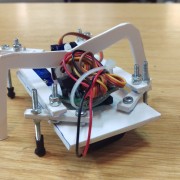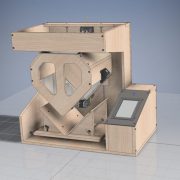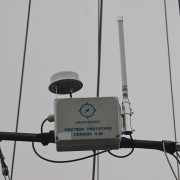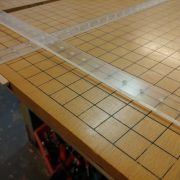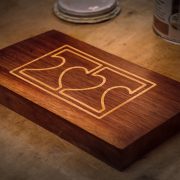Vacuum Forming Machine
Background
According to the founding myth, the association c-base e.V. in Berlin houses its member headquarters within the wreckage of a spacestation from the future that crashed through time and was buried over a million years old under what is the present-day capital city of Germany. This imaginative myth is a source of inspiration for members and connects the actual space with Berlin, since the Fernsehturm at Alexanderplatz is purportedly the main antenna of this legendary spacestation.
The daily activities of this association are largely governed by the ‘reconstruction’ of the spacestation, which means that the artifacts, wall panels and decorations are fashioned after a complex futuristic style. The former reconstruction materials mainly consisted of particle boards, hot glue, roof battens and paint. The vacuform machine accelerates and simplifies reconstruction, because complex wall panels can now be created in a matter of minutes, after the initial mould has been made.
Project Description and Requirements
The goal of the project was the creation of a machine to form plastomers through application of heat and vacuum. Commercially available machines usually require a floor space that is approx. 2 to 2.5 times larger than the size of the plastic sheets, and the costs for such a machine are typically well above 10,000€. The typical size of plastic sheets on the market is usually 2m x 1m. Thus, to minimize wasted material, I defined the size of the sheets for the machine as 1x1m. The available floor space for the machine was only 1.4m², ruling out the typical industrial design, which consists of a horizontally movable oven and a vertically movable mold. The difference between the size of a sheet and the required floor space should not be higher than a factor of 1.3. The available electrical outlets was limited to 3x16A at 230V, and from this, it followed that the total electrical power could not be higher than 10.8 kW
Mechanical Construction
A clamping frame is used to hold a sheet of thermoplastic during the molding process and is suspended in such a way, that it can be moved vertically. In the topmost position, the clamping frame is connected to the heat-shields of the oven. In the middle position, this frame can be fixed in place for loading and unloading plastic sheets. In the lower position, the clamping frame creates a seal with the suction table.
Initially, I planned to move the clamping frames along linear guides and rails, and created technical drawings and calculations with this in mind. However, upon realising which size and weight I would need for the machine base in order to deal with the resulting internal forces, I had to redesign my plans.
In the actual build, I abandoned the previously-envisioned machine base and constructed the whole device to be more flexible, so that the mechanical parts of the machine would not be subject to jams resulting from seasonal warping, uneven flooring, or various internal forces. This was accomplished by mechanically separating the guides and pulls: movement is accomplished through four metal wires on pulleys, and guiding is enabled through a quadrupel sarrus linkage. The Sarrus linkage has the advantage of limiting a translation to one dimension while preventing jamming.
The whole machine was constructed from 18mm Spruce boards. The covers for the oven were made from 22mm wood core plywood. The suction table was covered with 12mm phenolic resin-coated plywood.
Heating Elements
I had planned to create the necessary heating power through Wolfram-wires in free-hanging coils, and on the basis of this choice, we calculated the budget for this machine. During construction however, much of the crew objected to this decision and demanded a different way of heat generation. Eventually, we selected 12, 600W infrared quartz-glass tubes, which were then connected with heat-resistant silicone cable. Furthermore, I built an aluminium substructure from which to hang the heating elements, which equalises the distribution of heat.
Vacuumsystem
In the lower part of the machine is a black board, that has a matrix of 29×29 holes. This board covers an otherwise-airtight box, which is attached through its base to the hose of an industrial-strength vacuum cleaner. According to the spec sheet of said vacuum cleaner, it can evacuate the box down to 270 mBar (21.56 inHg), which is enough to suck a heated, pliable sheet of plastic tightly onto a mold. The vacuum is powered through a socket on the device, so both vacuum and oven may be controlled from the same wiring cabinet.
Costs
The total costs for the project were 1,050€. Initially, the budget was estimated at 600€, but through the required changes in the heating system these costs had to be re-evaluated. Approximately half of the costs were covered by c-base, and the other half by six individual c-base members, including myself.
Project Results
The machine is fully functional and is available to all members of c-base.
This video is a short clip of the creation of about twenty ceiling panels with the vacuum forming machine.






